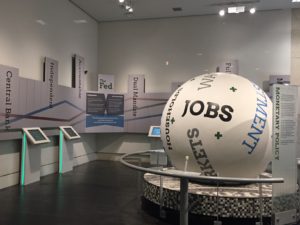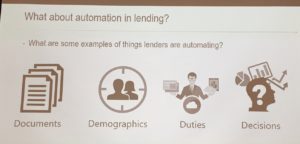 This year’s Forum concentrated on the use of technology in microlending – tools to do the lending and a way to close the bank referral loop. We are grateful to the Federal Reserve Bank for hosting us (that’s their lobby in the photo).
Three Tools for Microlending Automation (CAMEO members only morning session)
We’ve been encouraging members to incorporate technology into your lending process for several years to increase efficiency, save money, and increase volume. Technology is now a given for any serious microlender; and the choices are expanding. Susan Brown, CAMEO’s microlending expert, kicked off a great panel for our ongoing discussion on the topic.
This year’s Forum concentrated on the use of technology in microlending – tools to do the lending and a way to close the bank referral loop. We are grateful to the Federal Reserve Bank for hosting us (that’s their lobby in the photo).
Three Tools for Microlending Automation (CAMEO members only morning session)
We’ve been encouraging members to incorporate technology into your lending process for several years to increase efficiency, save money, and increase volume. Technology is now a given for any serious microlender; and the choices are expanding. Susan Brown, CAMEO’s microlending expert, kicked off a great panel for our ongoing discussion on the topic.
- Robert Lopez, COO, VEDC – Overview on VEDC’s automation project and why it is necessary
- Emily Gasner, CEO, Working Solutions – How the MMS automation has helped grow their portfolio
- Nick Elders, Vice President of Technology Solutions and Services, Spark presentation
 Spark is a new tool that automates what can be automated in the loan process – such as document collection, certain tasks and decisions. Nick Elders discussed how and why CDFI’s should automate and how his product can be customizable for organizations who want to keep their underwriting in-house (as opposed to MMS that uses LiftFund underwriters to give a recommendation on the loan.)
Daniel Fernandez talked about Opportunity Fund’s Community Partner Program. The program can supplement the missions and programs of other non-profits by serving as a microloan program for those who do not have one and complementing the services of those who do. Think of it as a white label credit product. Partners receive several benefits, including an in-depth look at the credit and underwriting criteria and a 5% commission on every qualified referral booked for loans between $5,000 and $50,000. For example, PACE doesn’t do loans for ITEN clients, but Opportunity Fund does, so PACE runs those loans through the program. If you have questions or are interested, please contact Robert Zapata.
After lunch, we heard about Project CUE from Tammy Halevy, Senior Vice President, New Initiatives, AEO. Banks make 8,000 declines a day which is an estimated $52 billion gap in funding to small and microbusinesses. Project CUE is a technical solution to the difficulty of closing the bank referral loop, something that we’ve talked about at past MicroLenders Forums. The platform provides an integrated place for bank declines to be shared and referred to CDFIs. This technology has great potential for lead generation as well as learning about credit issues through the backend data.]]>
Spark is a new tool that automates what can be automated in the loan process – such as document collection, certain tasks and decisions. Nick Elders discussed how and why CDFI’s should automate and how his product can be customizable for organizations who want to keep their underwriting in-house (as opposed to MMS that uses LiftFund underwriters to give a recommendation on the loan.)
Daniel Fernandez talked about Opportunity Fund’s Community Partner Program. The program can supplement the missions and programs of other non-profits by serving as a microloan program for those who do not have one and complementing the services of those who do. Think of it as a white label credit product. Partners receive several benefits, including an in-depth look at the credit and underwriting criteria and a 5% commission on every qualified referral booked for loans between $5,000 and $50,000. For example, PACE doesn’t do loans for ITEN clients, but Opportunity Fund does, so PACE runs those loans through the program. If you have questions or are interested, please contact Robert Zapata.
After lunch, we heard about Project CUE from Tammy Halevy, Senior Vice President, New Initiatives, AEO. Banks make 8,000 declines a day which is an estimated $52 billion gap in funding to small and microbusinesses. Project CUE is a technical solution to the difficulty of closing the bank referral loop, something that we’ve talked about at past MicroLenders Forums. The platform provides an integrated place for bank declines to be shared and referred to CDFIs. This technology has great potential for lead generation as well as learning about credit issues through the backend data.]]>
